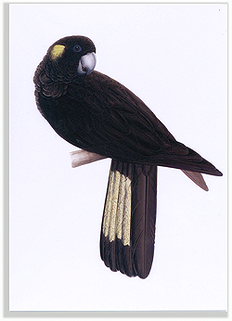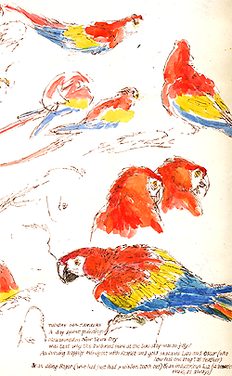previous | home page | this month | e-
Black Wings
Richard Bell’s nature diary, London, Tuesday, 12th May 2009, page 5 of 6
previous | home page | this month| e-

I’M HERE in London today for the opening of an exhibition of recent paintings and drawings by Elizabeth Butterworth at the Redfern Gallery. Her gouaches and watercolours include parrots, birds of paradise and birds of prey but the centrepiece of the exhibition is a series of black wing drawings, each 3 or 4 feet long, drawn in contë crayon. They resonate with power, not so much because of their scale but because of the measured intensity of observation in them. In the present constitutional crisis, if an angel of judgement was to be seen perched on the crenellations of the Palace of Westminster, it would have wings like these.
On a more intimate and inviting scale are her studies; I put on my reading glasses
for a closer look at these. My drawing journaler friend Roz Stehndahl has said that
she makes great efforts, when drawing birds, to observe the connection between beak
and feathery head -
I first met Elizabeth Butterworth when we were students at the Royal College of Art,
she in painting, myself in natural history illustration. I was curious to catch up
on her work and to see -
First Flight
But the assured tonal control in the black wings bring her full circle because, when I first met her, she was working a series of etchings in which soft, feathery wings were sometimes paired with shiny metallic jet engines. After 30 years, her work has lost none of its power.
In one corner there’s an elegant study of three feathers from a Lear’s Macaw. If they ever discover a new, related species it should be named Butterworth’s Macaw. Working in the same tradition, she’s a worthy successor to Edward Lear.
Yellow-

Detail from one of my student sketchbooks, Tuesday 14th January 1975; drawing Liz’s two scarlet and gold macaws, Lou and Oscar:
“Delightful birds. As soon as I’d walked in Lou waddled towards me and took the toe of my shoe in his beak. Then Oscar came along and there was an arguement as to who was entitled to bite my toe which was solved by them tackling a foot each. But they’re not allowed to try and pull visitors to pieces so they found other things to do. Lou found a tiny hole in the carpet and stuck his beak through that. They’re remarkably expressive in faces & gestures. Looking for the next thing they can do.”